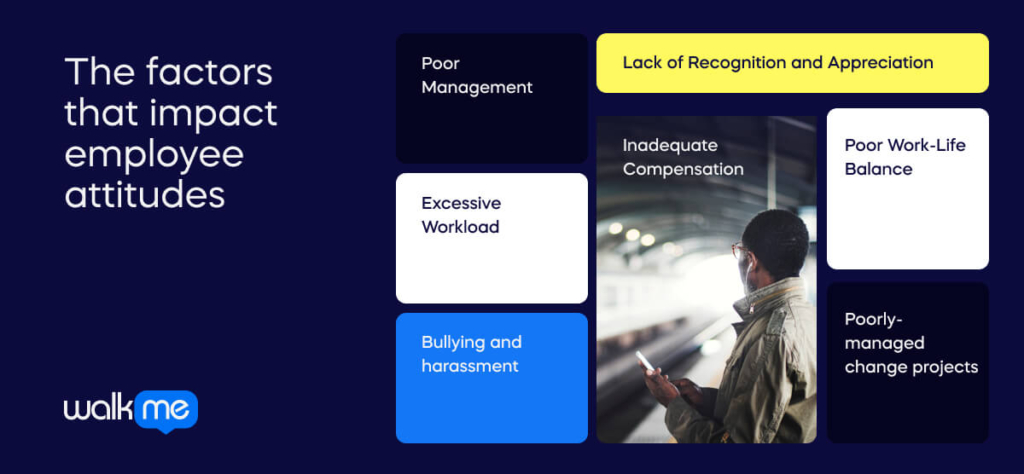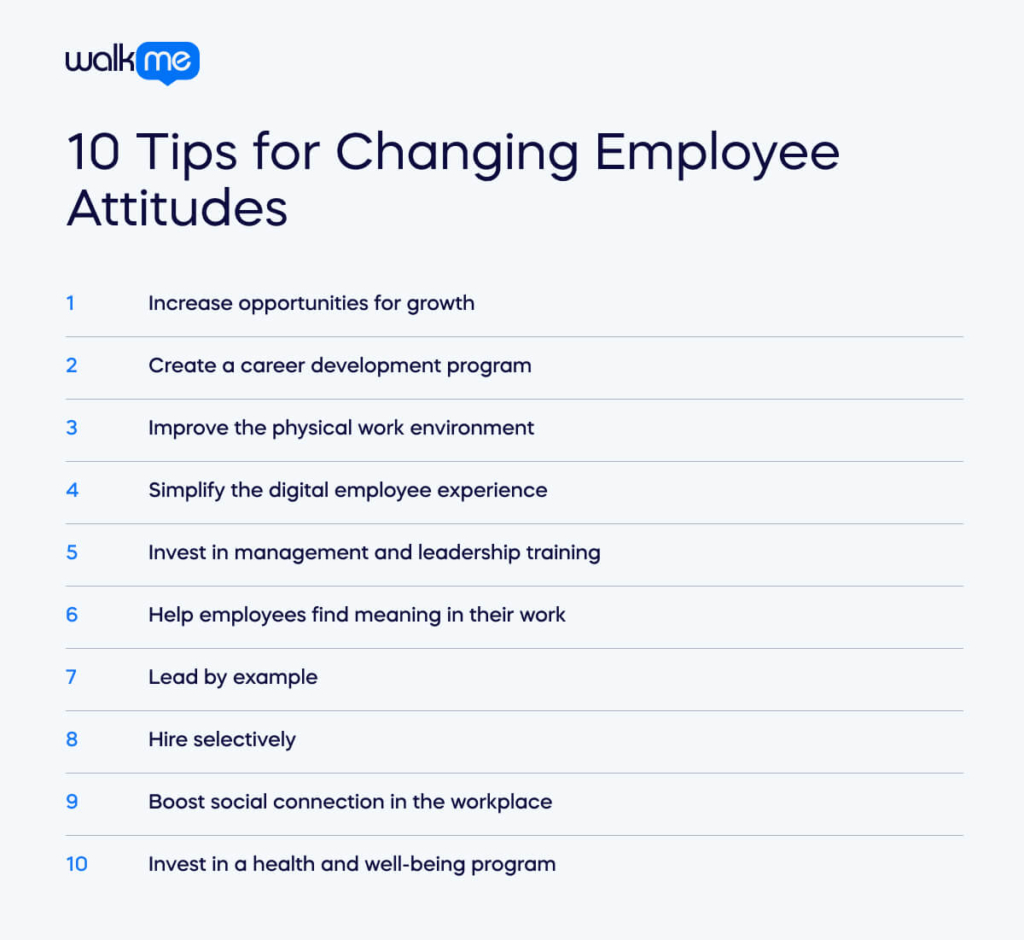Changing employee attitudes for the better is not easy, but it is possible. To achieve more positive attitudes, managers should ensure their organization has good opportunities for personal growth and career development opportunities, an exemplary work environment, and a meaningful well-being program.
Changing employee attitudes requires a mindset shift from leaders. Whereas employee performance metrics pressure employees to do their best, understanding employee attitudes requires leaders to improve the workplace.
Fortunately, some simple measures can positively impact employee attitudes, behaviors, and performance. This article will explain how to make that change!
It will:
- Explain the meaning of “employee attitude”;
- Examine the underlying factors that affect employee attitude;
- Introduce ten top tips for making your employees happier.
Although attitude change is not a part of strategic workforce planning, it’s an incredibly important aspect of the corporate world.
What do we mean by “employee attitudes”?
“Employee attitude” refers to an employee’s outlook towards every aspect of their work. It includes the feelings, beliefs, opinions, and perceptions towards an organization, its leadership, colleagues, and the working environment.
The importance of employee attitudes is not intuitively obvious. After all, if a staff member is doing their job, does it matter whether they are satisfied?
However, for a long time, business leaders and researchers have recognized that attitudes are a very important part of a positive work culture. For example, a classic 1979 HBR article by ORC researchers presented clear proof that employee values were changing dramatically – and having a major impact on the workplace.
Employee attitudes matter because they influence every employee’s behavior, performance, and job satisfaction. If employees come to work with a good attitude, your business will have fewer problems with retention, productivity, and succession planning.
The factors that impact employee attitudes

The factors behind employee attitudes and behaviors come from inside and outside the employee’s organization. Managers cannot control all of these factors. But with knowledge and understanding, they can certainly take steps to improve life for employees.
In general, poor attitudes in the workplace can come from many negative experiences.
They might include:
- Poor Management
- Lack of Recognition and Appreciation
- Excessive Workload
- Inadequate Compensation
- Poor Work-Life Balance
- Bullying and harassment
- Poorly-managed change projects
Such problems should (obviously) be removed by leaders as far as they possibly can.
Unfortunately, some factors affecting employee attitude in the workplace may be outside of the employee’s immediate control.
For example:
- Personal Values
- Family and Personal Life
- Health and Well-being
- Financial Situation
- Educational Background
- Life Events and Stressors
- Personality Traits
- Peer Influence
- Cultural Background
- Social and Political Factors
Managers will never be able to remove these problems from their staff. However, with sympathy towards this whole universe of complaints, leaders can work sympathetically. Doing that might be enough to turn a negative attitude into a positive attitude.
10 Tips for Changing Employee Attitudes

If you can keep up-to-date about your employees’ attitudes, you will already create a supportive environment for your workers. However, there is a lot more you can do to change attitudes in your organization. Here are ten ideas that might just work.
1. Increase opportunities for growth
If there are no pathways for upward mobility in the workplace, this can have a negative impact on employee attitudes.
After all, career development is essential for many workers, and it can directly impact their loyalty to an organization, employee retention rates, performance, and more.
Improving career opportunities begins with creating organizational promotional tracks and ensuring employees know them. Another important step is to support employees’ career growth.
2. Create a career development program
Growth opportunities are important for upwardly mobile employees. However, HR managers and business leaders who want to go one step further may wish to invest in an employee development program.
Through mentorship programs, employee training, career counseling, and similar efforts, these programs provide employees with long-term support for improving their career prospects, skills, and so forth.
That, in turn, can help employees have a more positive outlook at work and towards their employer.
3. Improve the physical work environment
Work environments can also have a direct impact on employees’ attitudes and the atmosphere of the workplace.
Interior décor, office equipment, the building, office location, office layout, and other elements of the workplace all have subtle but direct impacts on workers’ mindsets and psychological well-being.
Though the ROI of this investment may be difficult to quantify, it does affect workers. Asking workers for their input and ideas is a good way to improve the workplace.
4. Simplify the digital employee experience
The digital and physical workplace are intertwined and affect mindsets, attitudes, and behaviors.
In fact, the digital employee experience may be even more important than the physical work environment in today’s digital-first world. This was especially true during the COVID-19 pandemic when many businesses became remote.
5. Invest in management and leadership training
A surprising number of people will say their managers need more management training. Gallup’s research agreed, suggesting that managers account for over 70% of the variance in employee engagement.
Therefore, companies that wish to positively impact employee attitudes and engagement should assess their managers’ skills, their employees’ feelings about their managers, and how management in one’s own organization affects employee engagement.
Once that is done, employers can invest in leadership training and development courses that address the identified issues.
6. Help employees find meaning in their work
Employees’ work often positively impacts their customers and the world, though employees themselves may not be able to see this directly. As a result, they may not find their work meaningful, which can negatively impact their attitudes towards their work.
One way to help employees find more meaning in their jobs is by directly showing how their work positively affects customers. Good customer reviews or stories about the impact of their work, for instance, can help motivate employees and improve engagement.
7. Lead by example
One of the best ways to create the change you wish to see in the workplace is by embodying that change.
For example, managers who project positive attitudes are more likely to attract employees with positive attitudes and cultivate a happier workplace atmosphere.
8. Hire selectively
Hiring positive people is another straightforward way to build a more positive work atmosphere.
On the other hand, hiring employees with negative attitudes can influence the entire team, their behaviors, and their productivity.
9. Boost social connection in the workplace
Though there are always exceptions to every rule, teams who get along socially are often more likely to work well together. For instance, better informal communication management in the organization can also improve formal communication.
Adding opportunities for social connection can go a long way toward reducing friction, improving employee attitudes, and enhancing the workplace climate.
10. Invest in a health and well-being program
People’s health is often directly tied to their attitudes and mindsets. Naturally, employers cannot control employees’ health or how much they exercise.
However, a corporate well-being program can help reduce stress, boost employees’ emotional and physical health, and improve their attitudes.
Conclusion: Say goodbye to negative attitudes?
Commenters on the future of work are still forecasting that the pandemic era will dictate attitudes and dispositions for the coming years. In the face of the financial crisis, employees value their mental health and experience more than ever. As one 2021 McKinsey analysis puts it, “Workers are hungry for trust, social cohesion, and purpose.”
The changing attitudes of employees in 2023 make them value their self-confidence, recognize their self-esteem, and find motivation through personal encouragement. Every person is different, of course, but everyone wants their effort to be seen and rewarded by their manager.
If you can improve attitudes, you can hope for better performance in many aspects of your business. It’s well worth the effort!
Common Questions
Use stage-based assessments to understand where employees are (e.g., unaware, ready, acting) and customize interventions—such as education, coaching, or reinforcement—accordingly.
Well‑being alone won’t shift mindset. Embedding techniques like goal-setting and feedback loops increases motivation and sustains long-term attitude changes.
After upgrading physical or digital environments, follow up with guidance and skill-building to ensure employees adapt and leverage the changes fully.
Analyze underlying motivational or contextual barriers, then iterate your approach—mixing social proof, peer champions, or reframing—to unlock shift in resistant groups.

